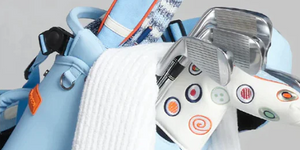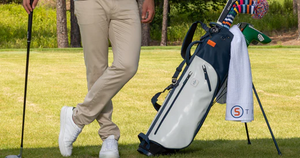How to Choose a Golf Bag That's Right for You
Would you buy a Rolex and carry it home in a plastic bag? The answer is an emphatic “No!” So why would you carry thousands of dollars of golf equipment in an Amazon golf bag that will fall apart faster than Happy Gilmore in a sand trap?
There is a vast selection of golf bags. However, finding one that won't have you panting to and from every hole will narrow the selection considerably.
Read on if you're looking for the details on what to look for in a Caddy's Best Friend! This is the ultimate golf bag buyer’s guide.
What Are the Different Types of Golf Bags?
Golf bags are not one-size-fits-all. Whether you're shopping online or in-person, it's essential to consider what type of golfer you are, what courses you'll be playing, and what other equipment and help (i.e., carts, caddies, and country clubs) will be available for the rounds ahead of you.
Below you'll find a list of the most common bags out there. While not exhaustive, this overview will help you pair the right bag with the right player.
Tour Staff Bags
Staff bags (also known as tour bags) are what you'll see the pros carrying—well, not actually carrying as they have professional caddies doing all of their heavy lifting. It makes sense, as these bad boys weigh over ten pounds (and that's before you've added any equipment).
If you're playing with the pros, this is an excellent investment. But if you're not competing in your first PGA tournament, chances are you'll be shoulder sore by the third hole.
There's a reason they're the bag of choice for anyone vying for the top spot at the masters. With pockets covering almost every square inch of these bags and clubs kept separate by size and category, these bags look and feel more like sleek, luxury suitcases than your average carrier.
Ready to play with the pros? Check out the STITCH SL Cart Tour Bag.
Cart Bags
For the serious golfer who's a couple of pars away from going pro, this is the bag you want. It’s the ideal set-up, as long as there's a four-wheeler to ferry you across the lawn.
Spacious and organized, these bags will save you the difficult choice of which clubs to bring along. The answer: all of them. Equipped with only one strap, they are unsuitable for walking the course and carrying great distances.
Instead, as the name implies, you'll leave this bag on the cart. A custom attachment on the bottom of these bags allows them to clip in and out of the cart easily.
While some cart bags stand up on their own, the weight can rack up because of their high storage capacity. Be careful! They're easy to tip over, and the slightest bump can have your loose equipment rolling down the slope if you're not looking. You'll be playing pick-up sticks instead of the greatest game ever played.
Stand Bags
This bag functions, as the name implies—a bag that stands on its own two feet (sorry for the pun). This bag features two retractable legs that propr it up as you take your shot. It lets you have an easy time selecting the appropriate club for your next swing.
Stand bags are a happy medium between cart and carry bags (we'll get to this one next). It’s easy to stow on a golf cart, but its moderate weight means it's not cumbersome. It can be slung over your shoulder for a full round if necessary.
Top-tier versions of this bag will have dividers and plenty of extra space for your B-side balls, wet-weather gear, umbrella, and a few other choice accessories. Just be careful with how much weight you place in it. Every support has its limits, and adding the golf ball that broke the camel's back mid-round is a lousy way to finish your game.
Who says spaciousness has to sacrifice comfort or style? Experience a lightweight stand bag with all the bells and whistles when you buy the STITCH SL2 Stand Bag.
Carry Bags
The carry bag is the perfect design for your caddy's day off. Don't have a personal caddy? You're not alone! The carry bag, also known as the Sunday bag, is an excellent choice for a beginner golfer hitting the course for the first time and a seasoned player who prefers to walk the course.
The carry bag is a classic, minimalist option that will save you some sweat as you carry your favorite clubs from hole to hole. You won't have a lot of room for much equipment past a couple of clubs, however.
The best carry bags are minimalist, equipped with one or two straps. It should be one of the lightest, no-nonsense bags on the market. You'll be carrying it for 18 holes, so it's best to avoid carry bags with too many add-ons or unnecessary frills. It's perfect for practice and friendly games.
An alteration to the carry bag that's worth exploring is one with a backpack strap style. This variation distributes the bag's weight evenly on your shoulders so that you won't place all the heft on one side of your body between swings. Double straps can be a game-changer for keeping your equilibrium intact for a long day out on the turf.
Keep it minimal, light, and stylish with the STITCH SL1 single-strap or the SL2 double-strap carry bag.
What to Look for in a Golf Bag
Whether you're hitting the range for the first time or teeing off with your boss every Sunday, the right bag will improve the quality of every round you play.
Understanding where you are in your golfing journey will help you know what's important to you in a bag. Narrow your choices down to the type of bag you're looking for (Carry, Stand, Cart, or Staff), then consider other features.
Once you've decided what type of golf bag is for you, what specifications should you be looking for in one? While there are probably hundreds of bag alterations that will provide you with a unique (though often superfluous) carrier, we think there are only five things to keep your eye on when shopping for your next bag: Dividers, Pockets, Straps, Style, and the Price Tag.
Experience and Bag Type
Here's where an honest assessment of your abilities and experience comes into play.
Are you just starting and playing once a month? Do you have 14 clubs to choose from and all the accessories to match?
A carry bag is a smart, dependable choice if you're only beginning to explore the sport. Its simplicity will keep you focused on the basics, which can take hundreds of hours to master, instead of searching through your bag and scrutinizing your equipment.
Are you starting to accrue more gear and want to test the nuance and difference between each club? Try the stand bag. Its versatility will allow easy access to a cart if available, and its weight won't wear you down if you have to walk.
If you're considering joining a golf club and feel up to some friendly competition, you're likely ready for a cart bag. It's probably time to begin fully stocking your bag with a complete repertoire of clubs and gadgets as well.
Finally, if you are lucky enough to have someone caddying for you or entering the professional tours, do yourself the favor of buying a top-of-the-line staff bag. Equipped with the best dividers and storage capabilities, you'll spend less time wondering where your favorite putter is and more time lining up your next shot. Your equipment will thank you.
Dividers
Are you comfortable in the chaos, or does your mind need a little more order to be able to focus? No one wants to spend too much time searching through 14 different clubs.
Dividers can help keep your mind and your clubs from getting jumbled. Be sure to check the length of each slot before buying your dividers, as some only go down halfway.
Whether you want them separated by category (woods, irons, hybrids, wedges, and putters), kept each on their own, or thrown together in a free-for-all, choosing the right divider is a crucial decision.
Pockets
Pockets can be a blessing or a curse. Too few, and you won't have enough room for all your gear. Too much, and you might be checking through every pocket, searching for where you hid your spare ball.
The main question when considering pockets is how much equipment do you have? Are you a gear head with a range finder, a divot repairer, and that extra pair of gloves? Or are you sticking to the basics?
Remember, the more you fill the bag, the more it weighs. So while having all that storage can be tempting, it might weigh you down before you've reached your second round.
Straps
A bag is only as good as your ability to carry it. A good strap (or a pair of them) should last you for years and keep your bag painlessly portable. A high-quality bag should have a single handle for hand-carrying and a single or dual strap.
Even the strongest golfers should look for high-quality strap cushions. A little padding will stop the straps from digging into your shoulders. Over time, that chronic stress adds up and can turn into some intense pain if you've got bad straps. Don't ignore the pain and leave yourself sore or injured. If your shoulders go, you can kiss your pain-free swinging days goodbye.
Style
For our more practical players, style might be the last consideration. Yet the way we dress and the pride we take in the quality of our belongings can profoundly affect mental and physical performance.
You've heard the phrase dress for the job you want, not the job you have. In this case, dressing for the type of player you want to be, not the one you are, can bring your game to the next level.
There's something to be said about a sleek bag with an attention to detail that compliments your style and swagger. Don't have a style or swagger just yet? It might be time to change that.
Price
Golf bags can cost anywhere from 100 to 1,000 dollars. It's typical to get what you pay for, but throwing down a grand isn't necessary to get a top-tier bag. As with most large purchases, setting a price range based on your budget, environment, and expected usage is paramount.
Buyers' remorse is a real phenomenon, especially if you have an unrealistic sense of how much action your golf bag will be getting. On the other hand, it can save you a lot of money if you invest in a high-quality product that will last for many years.
Investing upfront can save you the headache of replacing cheap gear that will break every six months.
FAQs
What Do the Best Golf Bags Have in Common?
Look for high-quality materials. The best bags combine durability with portability: a bag that won’t add another ten pounds to what you’re already carrying but won’t fall apart under its weight.
How Many Slots Should a Golf Bag Have?
The slots vary by bag and your needs. Typical slot arrangements are 4-way, 6-way and 14-way.
What Type of Golf Bag Is Best?
The best golf bag is the one that meets your needs and abilities. Finding the right bag isn't a one-choice-fits-all decision, so it's essential to consider all of the options discussed above.
Remember, golf bags are kind of like the cherry on top of the sundae. They're a fantastic way to reward yourself as you see improvement in your performance. Buying a lightweight bag today when you're 6+ over par means graduating to a heavier, more sophisticated bag when you're down to 120 strokes on an 18-hole course.
Explore Stitch Golf Bag's collection for all things golf today. You'll find the perfect bag for you and an array of classic accessories to have you playing and looking your best on the course.






